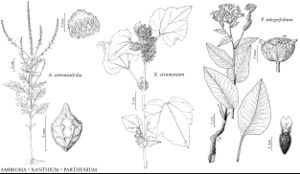Parthenium
Sp. Pl. 2: 988. 1753.
Gen. Pl. ed. 5, 426. 1754.
Annuals, biennials, perennials, subshrubs, or shrubs [treelets], 1–120 [–400] cm. Stems ± erect, usually branched. Leaves usually cauline, sometimes in rosettes; alternate; petiolate or sessile; blades elliptic, lanceolate, linear, lyrate, oblanceolate, obovate, ovate, rounded-deltate, spatulate, sometimes (1–) 2-pinnately lobed, ultimate margins entire or toothed, faces usually hairy and glanddotted (at least the abaxial). Heads usually radiate, sometimes ± disciform (P. alpinum), usually borne in corymbiform or paniculiform arrays (in glomerules in P. argentatum, borne singly in P. alpinum and P. ligulatum). Involucres ± hemispheric [rotate], 3–8 (–12+) mm diam. Phyllaries falling, 10 (–16) in 2 series, usually distinct (partially connate in P. alpinum), outer 5 (–8) herbaceous to scarious, inner 5–8 ± scarious to membranous. Receptacles flat to conic; paleae cuneate to flabelliform, scarious or membranous, distally papillate and/or fimbrillate, all or the peripheral each ± enfolding a disc-floret. Ray (pistillate) florets 5 (–8), fertile; corollas ochroleucous, tubes stout, glandular, laminae oblong to reniform or orbiculate, or ± coroniform (none in P. alpinum). Disc-florets 12–60+, functionally staminate; corollas ochroleucous, funnelform, lobes 5 (filaments distinct, anthers connate). Cypselae (black) oblanceoloid, obovoid, or pyriform, often ± obcompressed (shed together with subtending phyllary and 2 contiguous disc-florets and their investing paleae); pappi 0 (shoulders of cypselae may bear 1–3 pappuslike, triangular to ovate, or ± subulate enations). x = 9.
Distribution
New World, mostly warm-temperate and tropical, some temperate, in Old World
Discussion
Species ca. 16 (7 in the flora).
Selected References
Lower Taxa
Key
| 1 | Plants 1–2 cm (plants cespitose or forming mats); heads borne singly | > 2 |
| 1 | Plants (5–)15–120 cm (plants not cespitose or forming mats); heads in glomerules, or in simple or compound, corymbiform or paniculiform arrays | > 3 |
| 2 | Corollas of pistillate florets bearing laminae 1–2 mm | Parthenium ligulatum |
| 2 | Corollas of pistillate florets lacking laminae | Parthenium alpinum |
| 3 | Shrubs | > 4 |
| 3 | Annuals, biennials, or perennials | > 5 |
| 4 | Leaf blades oval-elliptic to obovate (sometimes pinnately 3–7-lobed or round-toothed, ultimate margins entire) | Parthenium incanum |
| 4 | Leaf blades lanceolate to oblanceolate (margins mostly entire, some with 1–5 sharp teeth) | Parthenium argentatum |
| 5 | Perennials; leaf blades usually crenate to serrate, sometimes coarsely toothed or somewhat lobed (then mostly toward bases); pappus-like enations from shoulders of cypselae 0 or 2(–4), erect to spreading, ± subulate or threadlike | Parthenium integrifolium |
| 5 | Annuals or biennials (sometimes persisting); leaf blades mostly 1–2-pinnately lobed; pappus-like enations from shoulders of cypselae 2, erect, ± deltate to ovate. | > 6 |
| 6 | Biennials (sometimes flowering first year or persisting); leaf blades ± pinnately lobed, abaxial faces strigillose (usually with erect hairs 1–2 mm as well) | Parthenium confertum |
| 6 | Annuals (rarely persisting); leaf blades (1–)2-pinnately lobed, abaxial faces scabrellous (seldom with erect hairs 1–2 mm) | Parthenium hysterophorus |

